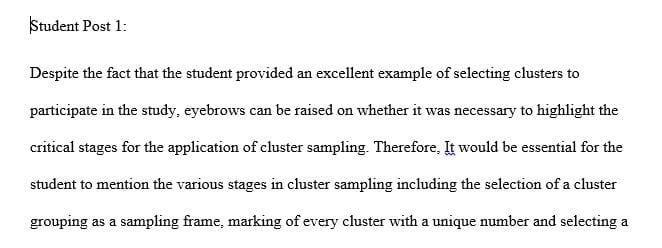One sampling method that is possible to use is referred to as “Cluster Sampling.
One sampling method that is possible to use is referred to as “Cluster Sampling.” In it, the entire population is divided into similar “clusters.” For example, if a survey is trying to extract data from a college on fraternity/sorority alcohol use, the clusters would be the individual fraternity and sorority houses. The surveyor would then randomly select a set number of clusters from the total number of clusters, and then would survey all of the members in the selected clusters. Continuing the example earlier, if the college had 30 fraternities and sororities, and they randomly selected 12 fraternities and sororities, all members of the selected fraternities and sororities would have to participate in the survey.
In order for cluster sampling to be effective, the clusters should to be relatively heterogeneous and therefore representative of the population as a whole. One of the issues with Cluster Sampling is the tendency of some clusters to be selected more often than others, or to have their opinions extrapolated over the entire population as a whole, despite obvious differences. For example, if one of the clusters happens to be of a different socio-economic make up than the population et al, then the survey will be skewed towards that particular cluster. This can be alleviated by expanding the number of sampled clusters, or by increasing the size of the clusters.
Resources:
The Pennsylvania State University. (2017). 3.5 Simple Random Sampling and Other Sampling Methods. Retrieved July 11, 2017, from https://onlinecourses.science.psu.edu/stat100/node/18
Vargnay, Arnaud. (2016). Cluster Sampling Bias in Government-Sponsored Evaluations: A Correlational Study of Employment and Welfare Pilots in England. Retrieved July 11 2017 from http://journals.plos.org/plosone/article?id=10.1371
STUDENT 2 POST
Although known as possibly the most pure form of probability sampling, random sampling still brings a form of bias. Random sampling is where “each member of the population has an equal and known chance of being selected.” (Statpac, 2017) In random sampling, the population is often annoyed and may quickly answer questions without stating honestly. Random sampling may also not be as random as believed. Random phone calls answered usually “tend to be [the] older” generations, in person contact is usually only agreed to by a certain type of person, which takes the random sample down. (“Simple Random Sampling and Other Sampling Methods”, 2017)
Due to the lack of motivation, the random sampling provides a specific form of bias called ‘motivational bias’. Motivational Bias may “cause a bias that does not reflect the decision maker’s true belief”. (Trident University, n.d.) I believe that in every study there is a bias that needs to be critically found. Once the bias is found, the findings of the survey or experiment will bring much more to light. Knowing why people are saying things is just as important as what they are saying. Just like reviews on yelp and amazon, the only people who answer usually are on one end of the spectrum, that they either had the best or worst time of their lives.
Businesses need to know if the sample has a certain kind of bias in order to make the correct decision. Decision making at times is only as good as the data collected. Poor data makes for poor decision making from higher corporate managers.
References
The Pennsylvania State University. (2017). 3.5 Simple Random Sampling and Other Sampling Methods. Retrieved July 10, 2017, from https://onlinecourses.science.psu.edu/stat100/node/18
StatPac. (2017). Survey Sampling Methods. Retrieved July 10, 2017, from http://www.statpac.com/surveys/sampling.htm
Trident University. (n.d.). Module 1- Background. Retrieved July 10, 2017, fromhttps://tlc.trident.edu/d2l/le/content/104339/view…
Answer preview to one sampling method that is possible to use is referred to as “Cluster Sampling.
APA
194 words



